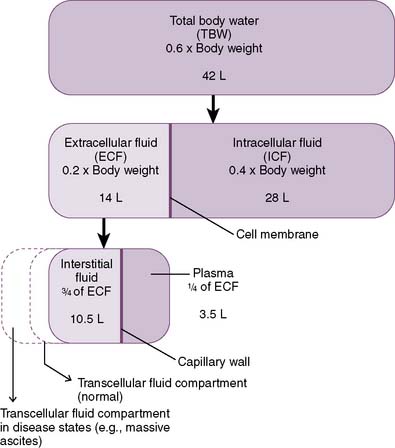

The composition of ICF is very different from extracellular fluid (ECF) ( Fig. The intracellular fluid (ICF) compartment comprises approximately 40% of body weight (approximately two thirds of total body water). The second edition of this book contains a more detailed discussion of the techniques involved in determination of total body water and the amount of fluid in the various compartments.Īs shown in Figure 1-1, the largest volume of fluid in the body is inside cells. Data from these kinds of studies vary with the protocol used and thus provide only approximations of fluid compartment sizes in healthy awake animals. Studies of body fluid compartments often are performed in experimental animals that have been anesthetized, splenectomized, or nephrectomized. Results are expressed either as a percentage of body weight, which is easy to measure when calculating fluid therapy needs, or as a percentage of total body water, which is a useful conceptualization of body fluid compartments. The volume of fluid in each of these compartments has been estimated using various isotope or dye dilution techniques and calculating their volumes of distribution. Body fluids in each compartment equilibrate with fluids in other compartments by multiple mechanisms across a wide variety of membranes to maintain homeostasis. Water is the major component of all body fluids, which are distributed into several physically distinct compartments.

Formulas for estimating lean body mass are based on the assumptions that (1) in normal small animal patients, approximately 20% of body weight is due to fat, (2) morbid obesity increases body fat to approximately 30% of body weight, and (3) body weight is a reasonable estimate of lean body mass in thin patients: 21 Because fat has a lower water content than lean tissue, fluid needs should be estimated on the basis of lean body mass to avoid overhydration, especially in patients with cardiac or renal insufficiency or in those with hypoproteinemia. 35 Total body water was approximately 70% of total body weight in racing Greyhounds, likely due to low body fat content.

13 Neonatal dogs and cats have higher total body water content (80% of body weight) than adults (60% of body weight), 30 and an age-related decrease in total body water has been described in puppies and kittens during the first 6 months of life. In humans, total body water decreases with age and is lower in women than in men. 56 There are some species and individual variations in total body water, likely related to age, sex, and body composition. 26, 59 Total body water of adult cats also was determined to be approximately 60%. Estimates of total body water in adult dogs that are neither very thin nor obese are 534 to 660 mL/kg. In health, approximately 60% of an adult animal's body weight is water. Vitreous humor is also useful for investigating glucose and ketones in combination with electrolyte analyses for the diagnosis of diabetic metabolic disorders, undernutrition, and hypothermia (cold exposure). Findings with regard to the cause of death are similar to those of blood for sodium, potassium, chloride, urea nitrogen, and creatinine, while calcium and magnesium do not show distinct differences between salt- and freshwater drowning. Vitreous humor has higher sodium and chloride but lower potassium, calcium, and magnesium concentrations than blood ( Table 8). However, electrolyte analysis is useful to supplement blood data.

It is a conventional material for forensic biochemistry, but available amounts and detectable biomarkers are very limited, lacking quick responders thus, its usage is practically very limited. Vitreous humor is a transcellular fluid in the eyeball, which includes biomarkers mainly derived from the diffusion of serum components ( Coe, 1993 Maeda et al., 2011 Palmiere and Mangin, 2012). Ishikawa, in Encyclopedia of Forensic and Legal Medicine (Second Edition), 2016 Vitreous humor


 0 kommentar(er)
0 kommentar(er)
